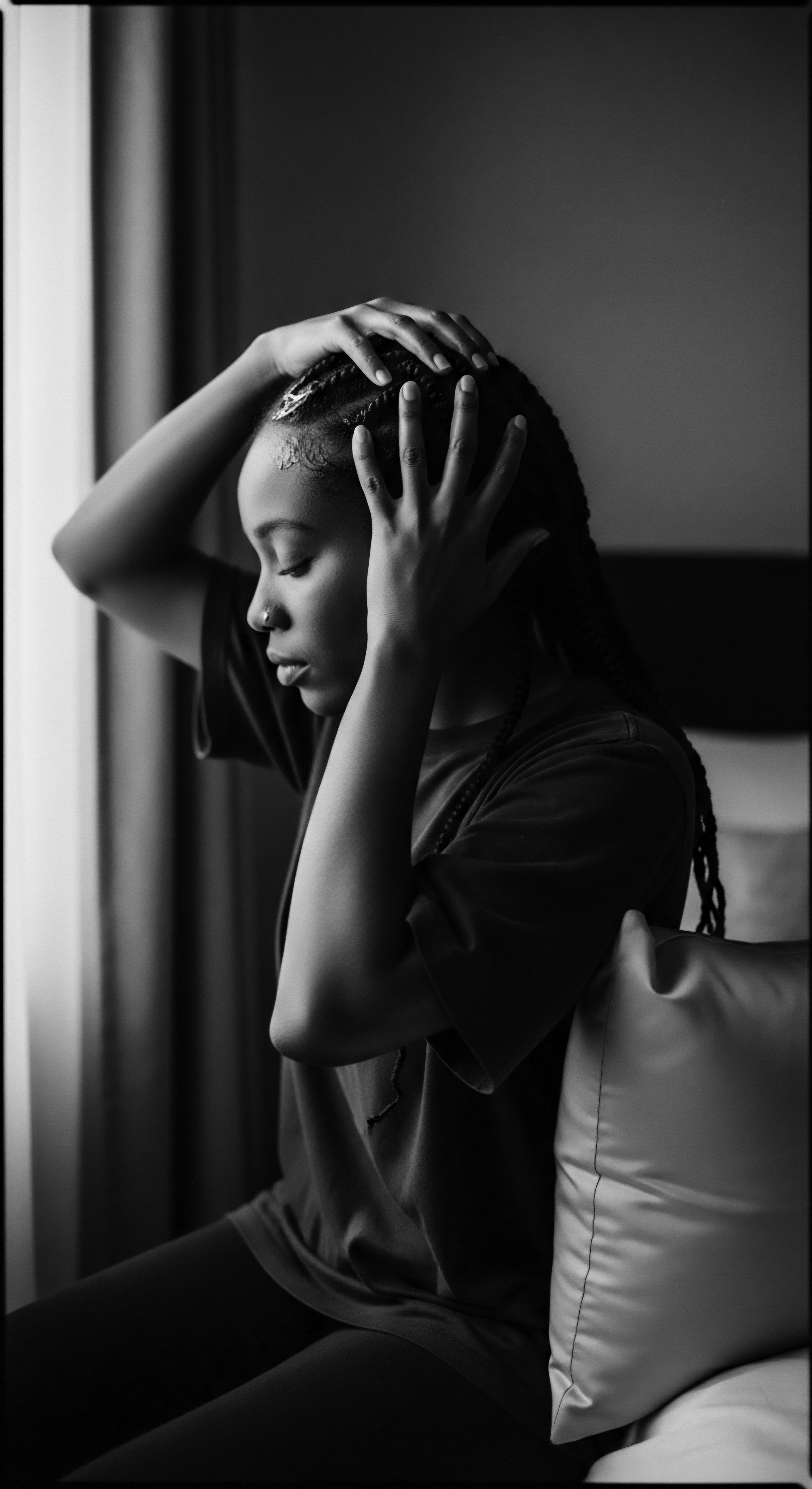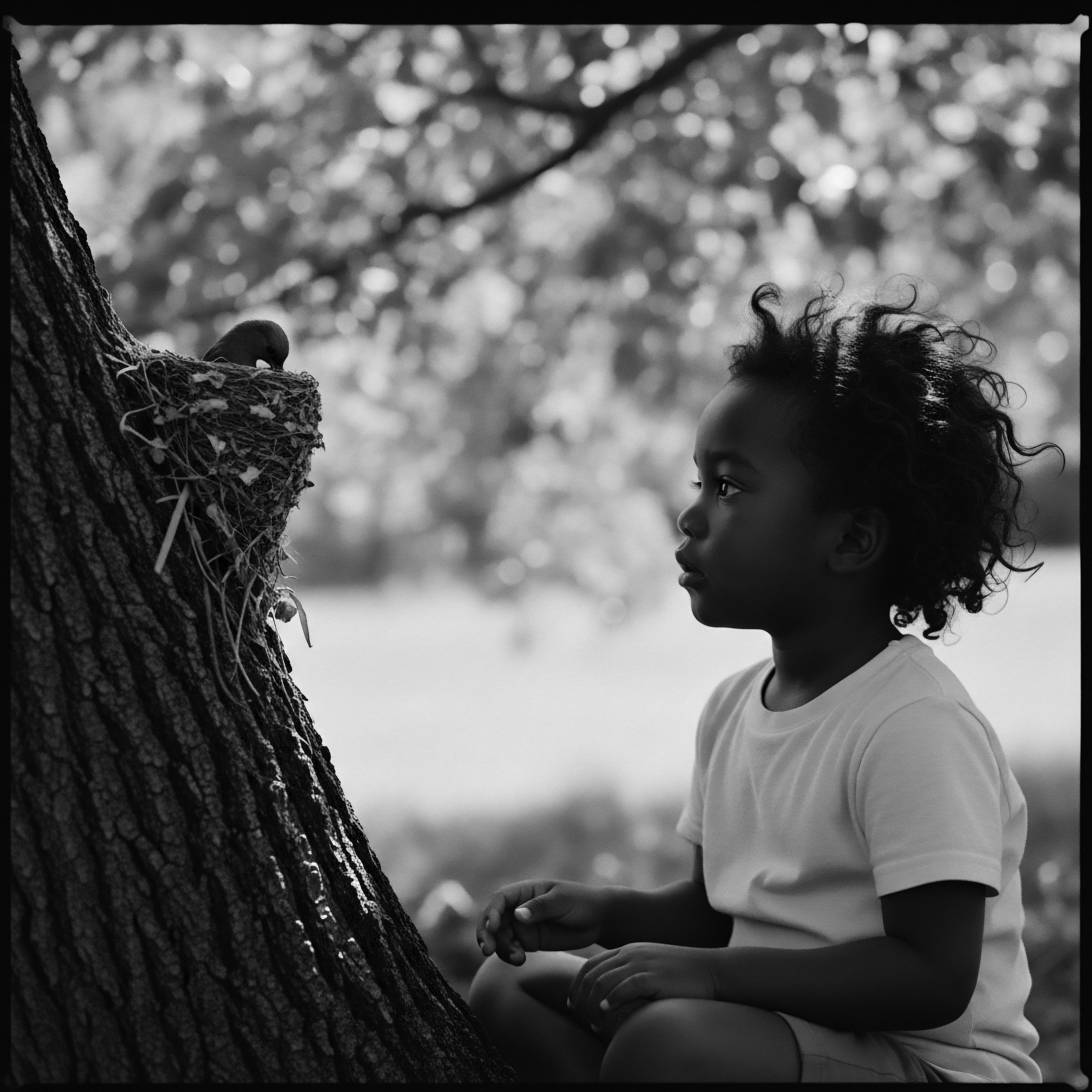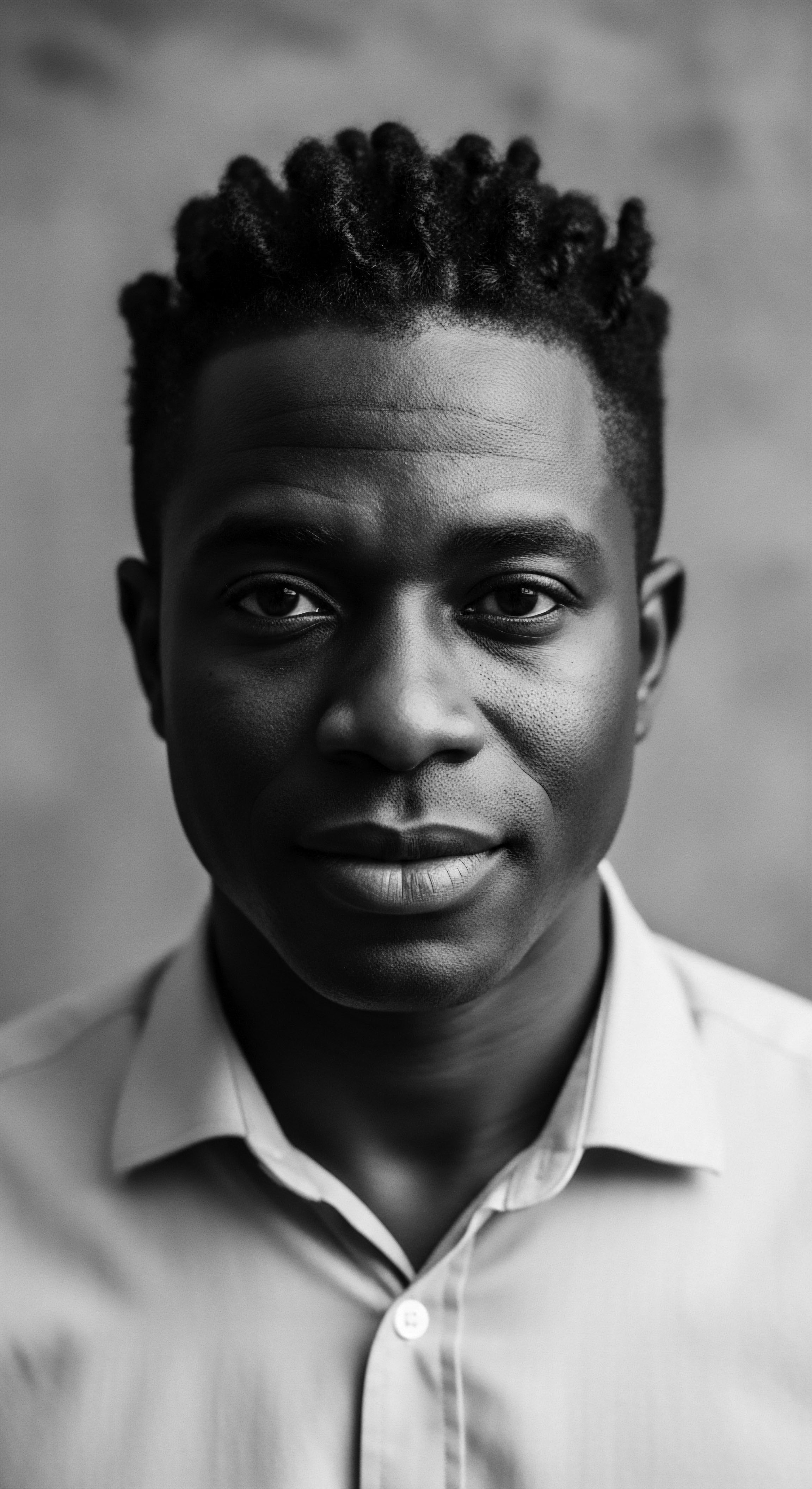
Roots
To stand upon the earth, feeling the steady thrum of existence, is to know that everything carries a lineage. For those with textured hair, this lineage spirals deep into the coiled memory of ancestral rituals, practices that shaped not only strands but entire communities. Your hair, in its glorious diversity of curl patterns, speaks a language of continuity, a wisdom passed down through generations. It is a living archive, a direct connection to a heritage rich in meaning and spirit.
Consider the earliest expressions of human care for textured hair, long before contemporary notions of beauty took hold. In ancient African societies, hair was regarded as a powerful extension of the self, a conduit for spiritual energy, and a direct link to the divine. Communities across the continent saw the top of the head as the point of entry for spiritual connection, rendering hair a sacred aspect of the body. This perception meant that the tending of hair was never a superficial act; instead, it was a profound ritual, intertwined with identity, social standing, and communal life.
Ancestral hair practices were not mere adornments; they were profound expressions of identity, spirituality, and social standing within communities.
The very structure of textured hair, with its unique bends and curves, necessitates specific care. Early communities understood this inherent quality. They did not attempt to force hair into unnatural forms but honored its natural inclinations. From this understanding sprang a wealth of techniques and tools, each refined over millennia.
The anatomical distinctions of textured hair, such as its elliptical cross-section and varied curl patterns, contribute to its distinct needs for moisture and protection. These biological realities were met with ingenious solutions rooted in the natural world.

Ancient Understanding of Hair
Before microscopes and biochemical analyses, ancestral cultures possessed an intuitive comprehension of hair’s elemental nature. They observed its growth, its response to moisture, and its capacity for intricate manipulation. The understanding of hair was not separate from the understanding of the self or the cosmos.
It was recognized as a visible marker, capable of conveying complex information about an individual’s place within the collective. This deep perception of hair as a living, communicative entity undergirded all care practices.
- Spiritual Link ❉ The belief that hair, as the highest point of the body, served as a channel for communication with the divine and ancestors.
- Social Blueprint ❉ Hair conveyed a person’s age, marital status, wealth, social rank, occupation, and tribal affiliation.
- Fertility Symbol ❉ Thick, long, and well-kept hair was often seen as a sign of fertility and a capacity for healthy offspring.
The essential lexicon of textured hair, even today, retains echoes of these ancient meanings. Words like “coil,” “kink,” and “curl” describe not just physical attributes but evoke the very spirit of the hair’s natural form. The historical environment also influenced these practices.
In regions with intense sun or dry air, protective styles and natural emollients became essential for survival and well-being. This symbiotic relationship between human ingenuity, the hair’s biology, and environmental factors formed the foundation of textured hair care heritage.

Ritual
The tending of textured hair, in ancestral contexts, transcended mere grooming; it blossomed into a ritual, a communal act steeped in tradition and care. This realm of practice, often carried out within families and communities, allowed for the transmission of knowledge, stories, and the strengthening of bonds. The meticulous attention paid to hair during these sessions was a reflection of its profound significance, a testament to its role in shaping identity and community cohesion.

Styling as Collective Heritage
Protective styles, which remain a cornerstone of contemporary textured hair care, possess ancient roots. Braiding, for instance, traces back thousands of years in African culture, with evidence dating as far back as 3500 BC. These styles were far from arbitrary. Each braid, each knot, often conveyed a specific message.
Cornrows, or “canerows” in some parts of the diaspora, were not simply practical styles but deep cultural identifiers. In pre-colonial West Africa, these patterns indicated ethnic backgrounds, geographical locations, and tribal affiliations. The Yoruba people of Nigeria, for example, crafted intricate styles symbolizing community roles. The Himba tribe in Namibia used distinct dreadlocked styles, coated with red ochre paste, to symbolize their connection to the earth and their ancestors.
Consider the sheer ingenuity of traditional tools. The Afro comb , a seemingly simple implement, has a documented history spanning over 5,500 years, with archaeological finds from Kush and Kemet (ancient Sudan and Egypt) revealing elaborately carved combs buried with their owners. These were not mass-produced items but often artistic pieces, sometimes engraved with symbols denoting tribal identity, rank, or protection.
The artistry involved in traditional hair styling speaks volumes about the value placed upon hair. Styles could take hours, even days, to complete, transforming hair into sculptural statements.
The enduring power of ancestral hair rituals lies in their capacity to transmit cultural knowledge and foster community bonds.
Traditional styling was often a communal event, particularly among women. These were moments of shared laughter, storytelling, and the quiet transfer of techniques from elder to youth. This social function of hair care—the gathering, the intimate touch, the exchange of wisdom—stands in stark contrast to the often solitary and commercially driven contemporary approach to hair styling.

Ancestral Ingredients and Their Legacy
The ancestral understanding of hair health extended to a deep knowledge of natural ingredients. Communities across Africa utilized what their local environments offered to cleanse, condition, and adorn hair. These were not chemically altered formulations but raw materials, recognized for their inherent properties.
- Shea Butter ❉ Derived from the nuts of the shea tree, indigenous to West Africa, shea butter has been a staple for centuries, prized for its moisturizing and protective qualities against harsh environmental elements.
- Coconut Oil ❉ In coastal regions, coconut oil provided moisture and shine, protecting hair from the sun and sea air.
- Aloe Vera ❉ Valued for its soothing and hydrating properties, aloe vera was applied to the scalp and strands to address irritation and maintain moisture.
- Herbal Rinses ❉ Various herbs and plant extracts were used to create rinses for cleansing, strengthening, and adding luster to hair. The Mwila tribe of Angola, for example, incorporated herbs alongside other natural elements to adorn their hair.
- Red Ochre Paste ❉ The Himba people of Namibia famously blended red ochre with butterfat to coat their hair, providing not only a distinctive aesthetic but also practical protection from the sun and insects.
These natural ingredients form the basis of many modern hair care products, their efficacy now validated by scientific understanding of their fatty acid profiles, vitamins, and minerals. The contemporary focus on “clean beauty” or “natural ingredients” is, in many ways, a return to these ancestral practices.
| Traditional Tool/Practice Afro Comb (wooden, bone, ivory) |
| Purpose and Heritage Detangling and styling textured hair, symbolic of status and identity for millennia. |
| Contemporary Parallel/Influence Wide-tooth combs and picks, often seen as symbols of cultural pride in the modern era. |
| Traditional Tool/Practice Hair Threading (Irun Kiko) |
| Purpose and Heritage Stretching hair, retaining length, protective styling; dating to 15th-century Yoruba. |
| Contemporary Parallel/Influence Heatless stretching methods, tension-based styling tools, focus on length retention. |
| Traditional Tool/Practice Natural Oils/Butters (Shea, Coconut) |
| Purpose and Heritage Moisturizing, protecting, sealing strands from environmental factors; ancient African wisdom. |
| Contemporary Parallel/Influence Emphasis on natural oils (e.g. jojoba, argan) and butter-based creams in contemporary product lines. |
| Traditional Tool/Practice Communal Braiding Sessions |
| Purpose and Heritage Social bonding, knowledge transfer, creation of intricate, symbolic styles. |
| Contemporary Parallel/Influence Hair salon as a community hub, shared styling experiences among friends and family. |
| Traditional Tool/Practice These traditional approaches illustrate a profound continuity, showing how tools and methods from antiquity continue to shape how we care for textured hair today, linking us to a rich heritage. |
The art of hair wrapping, too, has a deep lineage. From the elaborate Gele of West Africa to the vibrant turbans of the Caribbean, head coverings served varied purposes ❉ as symbols of heritage, status, or spirituality, and as practical protection against the sun. This tradition continued and even served as a form of resistance during periods of oppression, as seen with the Tignon Laws in 18th-century Louisiana, where enslaved and free Black women transformed forced head coverings into statements of dignity and style.

Relay
The journey of textured hair care, from ancient rituals to contemporary practices, represents a powerful relay of knowledge, resilience, and identity across generations. The inherent biological characteristics of textured hair – its tendency towards dryness, its unique coiling patterns, its propensity for shrinkage – meant that care practices were always geared towards moisture retention and protective styling. These ancestral insights, forged in environments often hostile to hair without proper care, laid the groundwork for much of what we recognize as effective today.

Ancestral Wisdom and Modern Hair Science
Understanding the elemental biology of textured hair helps us appreciate the genius of ancestral practices. The tight helical structure of coiled hair means that natural oils produced by the scalp have a more challenging path traversing the strand, making hair prone to dryness. This biological reality made ancestral deep conditioning and moisturizing rituals, using rich plant butters and oils, not simply aesthetic choices but a fundamental biological necessity for hair health. The use of natural materials like Shea Butter or Chebe Powder (traditionally used by the Basara Arab women in Chad for strength and length retention) directly addressed these needs, providing emollience and creating a protective barrier against environmental stressors.
Research into traditional hair practices in African communities has shown that ingredients like shea butter are rich in fatty acids and vitamins, which are now scientifically recognized for their conditioning and protective properties for hair fibers (Agyepong, 2017). This specific historical example powerfully illuminates how ancestral rituals shaped contemporary textured hair care by providing the very foundation for moisturizing and protective ingredient choices.
The ancestral ingenuity extended to techniques. Threading, an ancient African practice often known as “Irun Kiko” among the Yoruba people, involved wrapping strands of hair tightly with cotton thread. This method elongated the hair without heat, preparing it for further styling while protecting it from breakage.
Modern science understands that such tension-based methods, when properly applied, can temporarily stretch the hair cuticle, making it more manageable for styling and reducing friction, which in turn minimizes mechanical damage. The ancestral “pre-poo” concept – oiling hair before washing – directly addressed the hair’s tendency to lose moisture during cleansing, a practice now supported by studies demonstrating how oils can reduce hygral fatigue and protein loss during washing.

Community, Identity, and Resistance
The social dimension of ancestral hair care cannot be overstated. Hair styling was a collaborative act, building connections and strengthening community bonds. The person entrusted with tending another’s hair often held a respected position, sometimes due to a belief that a strand of hair could be used for spiritual purposes. This ritualistic sharing of space and touch reinforced communal identity.
The communal act of hair care, a practice dating back centuries, remains a testament to shared heritage and intergenerational connection.
During the transatlantic slave trade, the significance of hair transformed, yet its ceremonial role persisted through acts of quiet resistance. Enslaved Africans were often forcibly shorn, a deliberate attempt to strip them of their identity and heritage. Yet, the cultural memory of hair endured. Cornrows, in particular, became a covert communication system.
In Colombia, for example, cornrow patterns were used to create maps to escape routes, with specific designs indicating paths and distances. This historical example reveals hair care as a tool of survival, an enduring thread of ingenuity in the face of profound oppression. The practice of concealing rice seeds within braids also served as a means of survival, providing food for new beginnings upon escape.
The Tignon Laws of 1786 in Louisiana, which mandated that free Black women cover their hair, illustrate another moment where hair became a site of struggle and defiance. Far from being subjugated, these women adorned their forced headwraps with luxurious fabrics and jewels, transforming symbols of oppression into statements of defiant beauty and cultural pride. This transformation speaks to the deep psychological and communal importance of hair, and its ability to act as a voice for resilience.

From Sacred to Science ❉ A Continuity
The contemporary textured hair community continues this relay of knowledge. The popularity of “natural hair movements” globally represents a conscious return to ancestral practices, albeit often informed by modern scientific understanding. The rediscovery of ingredients like Black Castor Oil (with roots in African and Caribbean traditions) and the widespread adoption of protective styles like Braids, Twists, and Locs directly echo ancient customs. These styles are valued not only for their aesthetic appeal but for their efficacy in length retention and minimizing daily manipulation, lessons learned over millennia.
The concept of “nighttime sanctuary” in modern hair care, emphasizing bonnets and silk scarves, directly parallels ancestral protective habits. Though the materials might differ, the underlying principle of shielding delicate strands from friction and preserving moisture while at rest is a timeless practice, passed down through generations who understood the need for constant care. The continued use of these practices, often without conscious thought to their origins, is a testament to the enduring wisdom embedded within ancestral hair rituals.
| Aspect of Care Moisture Retention |
| Ancestral Practice (Pre-Colonial/Diaspora) Regular application of native plant oils (e.g. Shea, Palm, Coconut oil) and butters. |
| Contemporary Manifestation Use of leave-in conditioners, deep conditioners, and stylers with plant-derived oils and humectants. |
| Aspect of Care Protective Styling |
| Ancestral Practice (Pre-Colonial/Diaspora) Intricate braiding, twisting, threading, and knotting for long-term wear and protection from elements. |
| Contemporary Manifestation Braid-outs, twist-outs, Bantu knots, cornrows, and various extension styles to reduce manipulation. |
| Aspect of Care Tools and Techniques |
| Ancestral Practice (Pre-Colonial/Diaspora) Hand-carved wooden or bone combs; finger styling; communal hair grooming sessions. |
| Contemporary Manifestation Wide-tooth combs, detangling brushes, specialized styling tools; salon visits as social events. |
| Aspect of Care Hair as Identity |
| Ancestral Practice (Pre-Colonial/Diaspora) Hairstyles indicating social status, age, marital status, tribal affiliation, spiritual beliefs. |
| Contemporary Manifestation Hair as a statement of cultural pride, political resistance (e.g. Afro in Civil Rights era), and personal expression. |
| Aspect of Care The enduring principles of protecting and nourishing textured hair have seamlessly journeyed from ancestral wisdom to modern regimens, reflecting a continuous lineage of care. |

Reflection
As we close this contemplation of textured hair’s profound journey, a quiet truth settles ❉ our strands are more than mere protein structures. They are living conduits to a deep and resonant past, holding the echoes of every hand that has ever tended them, every story whispered during a communal styling session, every act of resilience woven into a braid. The ancestral rituals, born of necessity, spirituality, and collective wisdom, are not relics of a distant age. They breathe within our contemporary practices, whispering reminders of an enduring heritage.
Roothea’s ‘Soul of a Strand’ ethos is precisely this understanding ❉ that within each curl and coil resides a history, a spirit, and a future. The seemingly simple act of caring for textured hair today is, in fact, an acknowledgment of millennia of accumulated knowledge. It is a dialogue with ancestors who innovated with plant extracts and intricate patterns, who found ways to protect and adorn hair even in the harshest of circumstances. We stand on the shoulders of these traditions, finding that modern science often validates the efficacy of their time-honored methods.
To care for textured hair is to engage in a continuous conversation between past and present. It is to honor the ingenuity, the communal strength, and the spiritual reverence that characterized ancestral practices. This living legacy reminds us that beauty is not only external; it is profoundly internal, rooted in self-acceptance and a connection to something larger than ourselves. Our hair, a magnificent crown passed down through time, remains an expression of identity, an act of remembrance, and a beacon for the generations yet to arrive.

References
- Agyepong, G. (2017). “The Science of Shea Butter and Its Efficacy in Hair Care.” Journal of African Ethnobotany .
- Byrd, A. & Tharps, L. L. (2014). Hair Story ❉ Untangling the Roots of Black Hair in America. St. Martin’s Press.
- Gordon, M. (2000). Afro-Caribbean Hair and Beauty ❉ A Cultural History. University of Chicago Press.
- Omotos, A. (2018). “The Significance of Hair in Ancient African Civilizations.” Journal of Pan African Studies .
- Sieber, R. F. & Herreman, F. (2000). Hair in African Art and Culture. Museum for African Art.
- Tharps, L. L. (2001). Hair Story ❉ Untangling the Roots of Black Hair in America. St. Martin’s Press.
